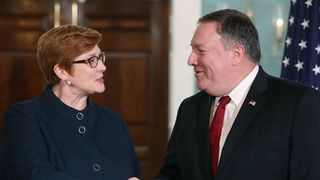The 30th round of the annual Australia-United States Ministerial Consultations (AUSMIN) will take place in Washington, DC on Tuesday amid immense global disruption and domestic strain accelerated by the spread of COVID-19. Our Indo-Pacific neighbourhood must be at the top of the agenda.
It’s hard to imagine a more urgent time for the Australia-US alliance to provide strong and collaborative regional leadership – and to double down on strengthening the resilience of the Indo-Pacific across its key dimensions, from health security and economic development to the balance of military power and defences against disinformation and cyber attacks.
It is equally hard to imagine a more difficult moment for our alliance to concentrate its energies on regional policy. With the US facing a pandemic-fuelled health crisis, nationwide social unrest, escalating debt and an epoch-defining election in November, and with Australia only tentatively emerging from the first wave of the pandemic, both countries have politically charged distractions at home.
Our shared national interests in fostering a healthy, stable and resilient Indo-Pacific cannot be postponed and must be wholeheartedly embraced at AUSMIN 2020.
But our shared national interests in fostering a healthy, stable and resilient Indo-Pacific cannot be postponed and must be wholeheartedly embraced at AUSMIN 2020.
Three principles should guide this year’s talks between Foreign Minister Marise Payne, Defence Minister Linda Reynolds and their American counterparts.
First, helping our Indo-Pacific neighbours to sustainably recover from the pandemic is the most urgent priority, and is in all of our interests. With more than 600,000 cases of COVID-19 throughout the region – coupled with a rapidly deteriorating health, economic and developmental outlook that will see regional growth fall to near zero per cent and leave 24 million people languishing in poverty – the scale of the crisis vastly outstrips our current capacity to respond.
This places a premium on the need for Canberra and Washington to invest more resources into human security initiatives – immediately and for the future – and to accelerate efforts to provide innovative, high-quality solutions to developmental challenges.
Focusing our respective development financing mechanisms towards shoring-up Pacific health systems and pandemic preparedness would be a good start. Reinvigorating the vaunted but so far low-achieving US-Australia-Japan trilateral development partnership – including its stalled Blue Dot Network – to deliver high-standard infrastructure projects across south-east Asia is another obvious candidate for action.
As our economic and security interests hinge on the overall health of stable, sovereign and well-governed regional nations, supporting their pandemic recovery will assist our own.
Second, strengthening the alliance’s contribution to deterring aggression and coercive statecraft must proceed with urgency despite the pandemic.
New economic burdens are limiting the capacity of regional countries to counterbalance Chinese power: they are putting downward pressure on defence budgets, placing the imperatives of domestic recovery ahead of geopolitical concerns, and leaving some more vulnerable to Beijing’s strategic largesse than before.
Our region’s strategic landscape has been rapidly deteriorating due to America's declining capacity to maintain a favourable balance of power and China’s increasingly assertive use of grey zone tactics – such as disinformation, maritime coercion and foreign interference – backed by its growing military might.
The pandemic is only exacerbating these trends. New economic burdens are limiting the capacity of regional countries to counterbalance Chinese power: they are putting downward pressure on defence budgets, placing the imperatives of domestic recovery ahead of geopolitical concerns, and leaving some more vulnerable to Beijing’s strategic largesse than before.
In the US, the tumultuous health, economic and sociopolitical consequences of the pandemic are sharpening policy preferences for self-strengthening at home and will quicken the decline of resources for defence. China, meanwhile, is taking advantage of a distracted region to advance an expansive geopolitical agenda – vigorously flexing its muscles from Hong Kong and the Sino-Indian border to Taiwan, the South China Sea and the Pacific.
Regional partners need more support
This situation calls for the alliance to invest more heavily in supporting regional partners against Chinese coercion and to urgently divest itself from strategically wasteful military engagements in the Middle East.
Canberra and Washington should increase combined patrols with south-east Asian armed forces to raise the costs of aggression for Beijing; and should step up the provision of intelligence to our regional partners to help them respond to Chinese adventurism, as Australia has reportedly agreed to with Indonesia.
To optimise the alliance for these challenges, Australia and the US should establish co-ordinating mechanisms for countering Chinese disinformation – particularly where it aims to discredit our resilience-building efforts – and should introduce a series of Indo-Pacific workshops, military exercises and peacetime operations to develop new ways of deterring a more aggressive China.
Finally, signalling Australian and American preferences for how we want our respective Indo-Pacific strategies to evolve in the coming years is critical for domestic and regional audiences. This will entail a focus on differences as well as shared interests.
Although the US and Australia have common objectives in strengthening a stable, prosperous and rule-governed regional order, we have quietly diverged in recent years over multilateralism, global institutions, international trade, regional diplomacy and other norms.
Differences over China policy are perhaps the most sensitive. Whereas Washington has adopted an increasingly strident public tone that casts China as an ideological threat, Canberra seeks a less politicised approach and has publicly supported engagement alongside a firming-up of our China strategy.
These distinctions don’t undermine alliance solidarity, but they necessitate different tactics.
As Australia’s internationalist outlook is far more in keeping with regional policy preferences in south-east Asia and the Pacific than America’s current attitude, Canberra should fully embrace it during and after AUSMIN. This means using current points of difference with Washington as markers for how Australia would prefer to work with the US in the future – and how we will continue to work with the region to bolster resilience until then.






